 |
Dirk Matten und die
Beatles
Hier
die Geschichte, alles ist wahr, Ehrenwort!
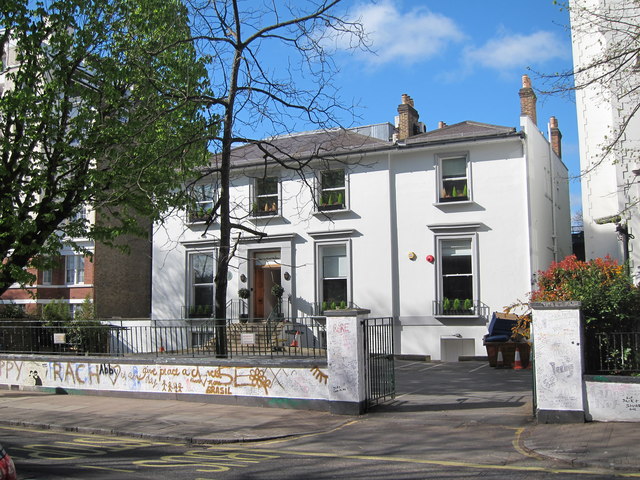
Mit meinem besten Freund Lutwin Hieronymi habe ich im Sommer 1969 zwei Wochen in London verbracht. Wir hatten im Melody Maker gelesen, dass die Beatles eine Art Büro mit dem Namen APPLE besaßen. Wir sind - der 5. August 1969 war's –- morgens gleich hin, man sagte uns aber, die Beatles würden heute im EMI-Studio in der Abbey Road aufnehmen. Dort haben wir eine gute Stunde mit weiteren Fans gewartet. Dann kam Paul McCartney im Mini-Cooper auf den Hof gefahren. Alle sind hin, um sich ein Autogramm geben zu lassen. Wir waren natürlich viel zu stolz. Paul begrüßte seine Fans ganz herzlich und gab ohne Stress und Hektik Autogramme. Eine Stunde später ging’s dann richtig los: Erst kam George Harrison und dann Ringo (total feist beide Arme ausgestreckt auf dem Rücksitz). Beide im Rolls Royce.
Dann kamen John Lennon und Yoko Ono, beide weiß gekleidet. Wir standen an dem berühmten Aufgang zur Eingangstür der Studios und John ging direkt an mir vorbei. Ich konnte nicht anders, ich habe spontan ganz laut „RINGO“ gerufen. John Lennon hat unheimlich verwundert geguckt.
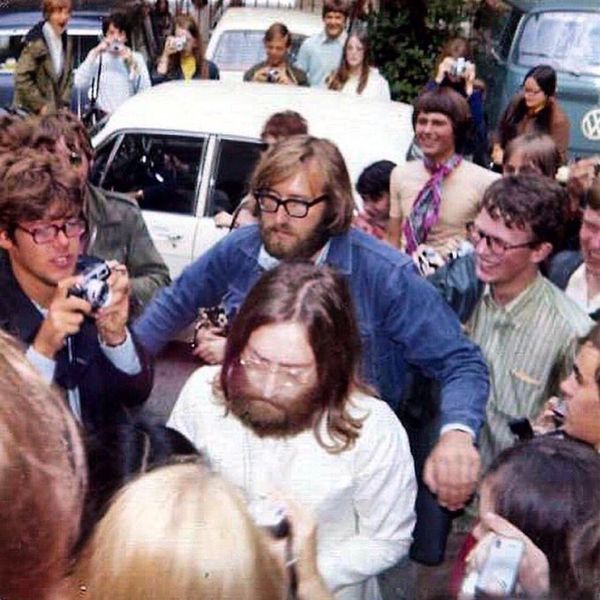
Danach kam George Martin, ich glaube in einem offenen englischen Sportwagen. Den Beatles Produzenten George Martin hatte ich schon immer irgendwie bewundert. Ich bin hin und habe mir dann doch ein Autogramm auf die Rückseite des Mitgliedausweises vom Marquee Club geben lassen.
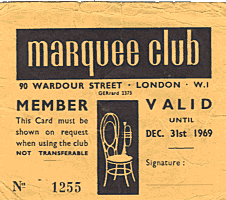  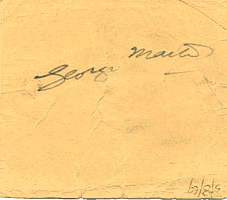

Dirks
Marquee Club Ausweis mit Autogramm
von George Martin auf der Rückseite |
Nach
Jahren habe ich mal in einem Buch gelesen, was die Beatles an diesem
5. August 1969 im Abbey Road Studio so getrieben haben. Na, wenn
das keine Fügung war:
Mark
Lewisohn ‘The Beatles: Recording Sessions’
Harmony
Books, New York, ISBN 0-517-57066-1
Tuesday
5 August 1669
Home
experimentation with Brennell tape machines had not ended with Revolver.
Paul McCartney, in particular, would still spend spare time in the
sound equipment room of his St John's Wood house, making tape loops.
On this day, 5 August 1969, Paul took a plastic bag containing a
dozen loose strands of mono tape into Abbey Road, where - together
with the production staff - he spent the afternoon in the studio
three control room transferring the best of these onto professional
four-track tape. The effects - sounding like bells, birds, bubbles
and crickets chirping allowed for a perfect crossfade in the medley,
made on 14 August, from 'Sun King' into 'You Never Give Me Your
Money' , solving the problem first brought to light in the experimental
edit on 30 July. (Note. Inside the plastic bag was another tape
loop which Paul intended for George's 'Here Comes The Sun'. It was
never used.)
  

 George Martin, Paul McCartney, Ringo Starr George Martin, Paul McCartney, Ringo Starr

|
It
seems somehow apt that the Beatles should have been among the first
to make use of a new musical instrument which, after their demise,
would shape the future of rock music almost as profoundly as they
had done: the synthesizer, as invented by one Dr Robert Moog. Compared
to today's microchip microeverything, the early "Moog's"
were veritable monstrosities, with a huge bank of wires and a large
two-tiered keyboard. George Harrison, in particular , expressed
great interest in the invention and bought one early in 1969, recording
an album at his home, Electronic Sounds, full of its strange noises,
which was released in May by Apple's short-lived "experimental"
offshoot, Zapple. Now, in early August, George had his Moog transported
into EMI for the Abbey Road sessions, and with Mike Vickers the
Manfred Mann instrumentalist who also conducted the 'All You Need
Is Love' orchestra recruited as expert consultant / programmer,
the Beatles began to make constructive use of the instrument in
the closing weeks of the Abbey Road sessions.
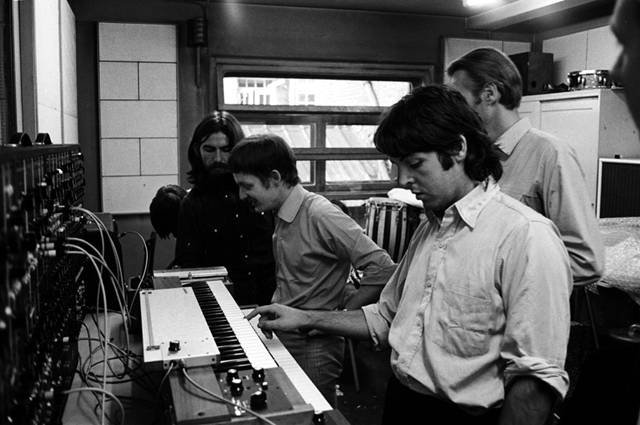
"The Moog was set up in Room 43," recalls John Kurlander,
"and the sound was fed from there by a -mono cable to whichever
control room we were in. All four Beatles - but particulary George
- expressed great interest in it, trying out different things."
"Everybody was fascinated by it," says Alan Parsons. "We
were all crowding around to have a look. Paul used the Moog for
the solo in' Maxwell's Silver Hammer' but the notes were not from
the keyboard. He did that with a continuous ribbon-slide thing,
just moving his finger up and down on an endless ribbon. It's very
difficult to find the right notes, rather like a violin, but Paul
picked it up straight away. He can pick up anything musical in a
couple of days. "
"I think the Beatles used the Moog with great subtlety."
says Nick Webb. "Others in a similar situation would probably
have gone completely over the top with it. It's there, on the record,
but not obtrusively. Perhaps they weren 't sure it was going to
catch on!"
'Because' was the recipient of the first Moog overdubs, played by
George and recorded twice, for the last two available tape tracks,
in a studio two session commencing at 6.30pm. With this, the song
was complete.
The final overdub on this day was of voca1s for 'The End', the song's
first.
(Note.
Concurrent with these activities, between 8.00 and 9.30 pm, balance
engineer Tony Clark and tape operator Alan Parsons were in the control
room of studio three making a stereo reel-to-reel tape copy from
an ordinary cassette of some of John and Yoko's latest privately
recorded sounds. The tape was taken away by the Lennons' assistant,
Anthony Fawcett.)
  

Index
siehe
auch:
Anzeige in Keyboards 03/1987

.
The
Early Years | Inside '99
| Ereigniswelt | Business
Art
Gästebuch
| Kontakt | Credits
| Start
..

.
Die Synthesizerstudio Bonn History
 = Popup-Fenster
(JavaScript aktivieren!) = Popup-Fenster
(JavaScript aktivieren!)
©2001
|
 |